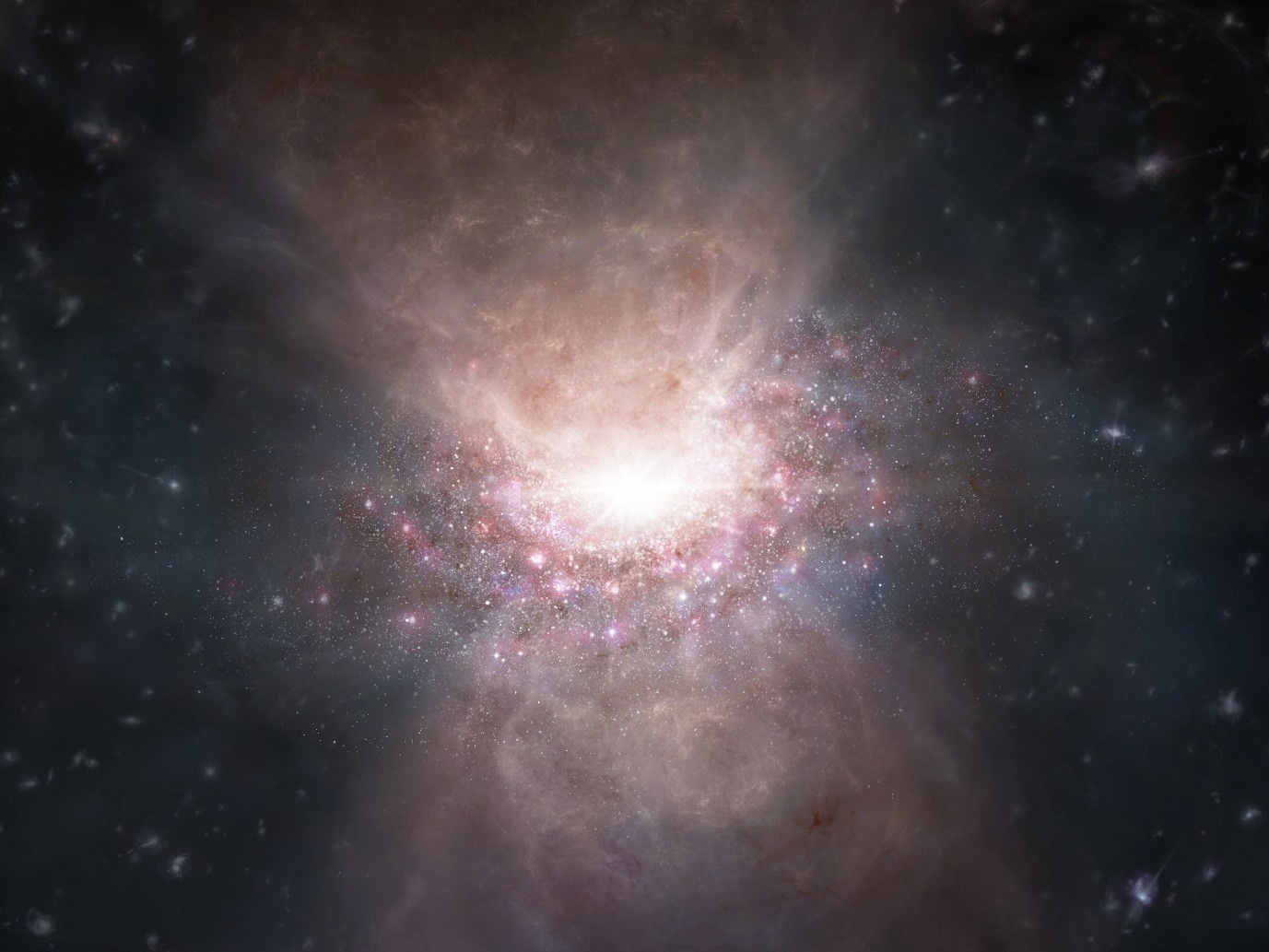Theoretical predictions have been validated with the identification of a molecular gas outflow from a quasar during a period when the Universe was under one billion years old.

Artist’s impression of an outflow of molecular gas from the quasar J2054-0005. Image Credit: ALMA (ESO/NAOJ/NRAO)
A quasar is a small area in the center of a massive galaxy that is powered by a supermassive black hole. They have a pointy appearance akin to stars, are incredibly bright, and are very far away from Earth. Because of their brightness and distance, they offer a window into the conditions of the early Universe, which was formed less than a billion years ago.
Researchers led by Professor Akio Inoue of Waseda University, Assistant Professor Takuya Hashimoto of the University of Tsukuba, and Assistant Professor Dragan Salak of Hokkaido University have found the first indication of star formation suppression caused by a molecular gas outflow in a quasar-host galaxy in the early Universe. The Astrophysical Journal published their findings, which were based on observations they made in Chile with the Atacama Large Millimeter/submillimeter Array (ALMA).
A molecular gas is necessary for the stars to form. The abundance and high concentrations of molecular gas within a galaxy serve as the main fuel for star formation, which would result in the formation of a large number of stars. Molecular outflows effectively suppress the formation of stars in galaxies that host quasars by expelling this gas into intergalactic space faster than it could be consumed by star formation.
Theoretical work suggests that molecular gas outflows play an important role in the formation and evolution of galaxies from an early age because they can regulate star formation. Quasars are especially energetic sources, so we expected that they may be able to generate powerful outflows.
Dragan Salak, Assistant Professor, Hokkaido University
The quasar that the researchers saw, J2054-0005, has an extremely high redshift, meaning that it and Earth appear to be moving apart very quickly.
J2054-0005 is one of the brightest quasars in the distant Universe, so we decided to target this object as an excellent candidate to study powerful outflows.
Takuya Hashimoto, Assistant Professor, University of Tsukuba
The scientists watched the quasar's molecular gas outflow using ALMA. ALMA was essential to this study because it is the only telescope in the world with the sensitivity and frequency coverage to identify molecular gas outflows in the early Universe.
Speaking about the method used in the study, Salak comments: “The outflowing molecular (OH) gas was discovered in absorption. This means we did not observe microwave radiation coming directly from the OH molecules; instead, we observed the radiation coming from the bright quasar—and absorption means that OH molecules happened to absorb a part of the radiation from the quasar. So, it was like revealing the presence of a gas by seeing the ‘shadow’ it cast in front of the light source.”
The results of this study provide compelling evidence for the existence of strong molecular gas outflows from quasar-host galaxies and their influence on galaxy evolution during the early cosmic era.
Molecular gas is a very important constituent of galaxies because it is the fuel for star formation. Our findings show that quasars are capable of suppressing star formation in their host galaxies by ejecting molecular gas into intergalactic space.
Dragan Salak, Assistant Professor, Hokkaido University
This study was supported by the ALMA Japan Research Grant of National Astronomical Observatory of Japan (NAOJ) Atacama Large Millimeter/submillimeter Array (ALMA) Project; Leading Initiative for Excellent Young Researchers, Ministry of Education, Culture, Sports, Science and Technology of Japan; Society for the Promotion of Science (JSPS) KAKENHI; National Science Center (NCN) SONATA; and the Japan Science and Technology Agency (JST) SPRING.
Journal Reference
Salak, D., et al. (2024) Molecular Outflow in the Reionization-epoch Quasar J2054-0005 Revealed by OH 119 μm Observations. The Astrophysical Journal. doi.org/10.3847/1538-4357/ad0df5.